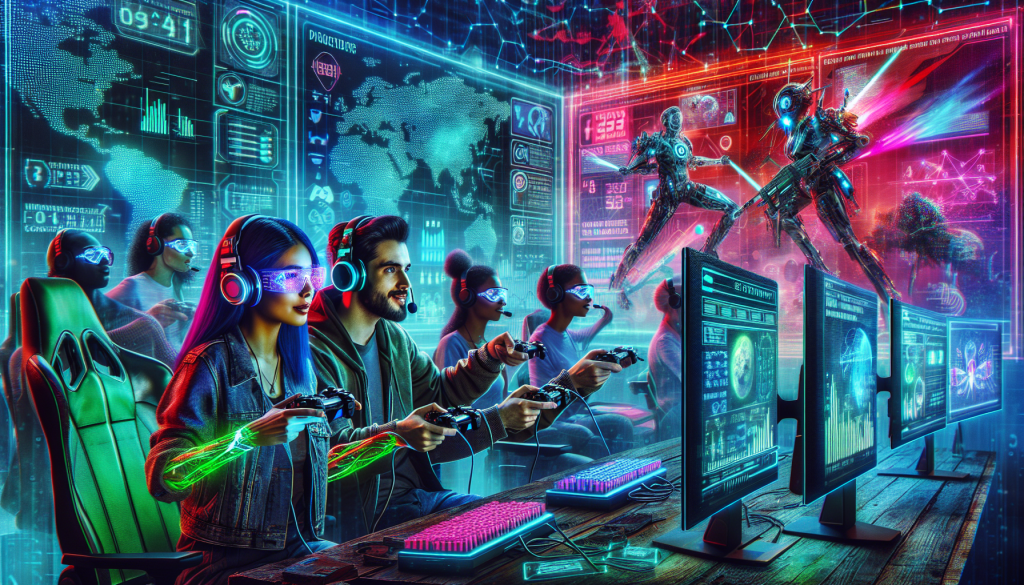Influence of Gaming Journalism: Reporting and Commentary in the Gaming Industry
Gaming journalism plays a crucial role in shaping the discourse within the gaming industry and providing valuable information to players. Journalists in this field not only report news and provide updates but also offer critical analysis, investigate industry secrets, engage with the gaming community, predict industry trends, and maintain the highest ethical standards. In this article, we will explore the impact of gaming journalism and how it helps players make informed decisions.
When it comes to reporting news, gaming journalists are at the forefront of delivering timely and accurate information to players. They keep gamers informed about game releases, updates, and industry events. By reporting on these developments, journalists shape players’ expectations and create anticipation for upcoming games. Whether it’s announcing the release date of a highly anticipated title or revealing details about game mechanics, news reporting is crucial in keeping players in the loop.
Critical analysis is another essential aspect of gaming journalism. Journalists provide in-depth evaluations of various aspects of games, such as mechanics, storytelling, graphics, and more. Their analysis helps players gauge the quality of a game and make informed purchasing decisions. Moreover, developers pay attention to critical analysis as it influences their design choices, pushing them to deliver high-quality games that cater to players’ preferences.
Investigative reporting is also a vital component of gaming journalism. Journalists dig deep to uncover industry secrets, controversies, and unethical practices. Their investigations hold game developers and publishers accountable for their actions, ensuring transparency and fairness within the industry. By shedding light on these issues, journalists help players make informed choices and also contribute to the overall improvement of the gaming industry.
Gaming journalism is not just about reporting and analysis; it also fosters community engagement. Journalists actively interact with players, listen to their feedback, and amplify their concerns. They provide a platform for marginalized voices within the gaming community, ensuring their opinions are heard. This engagement helps to create a more inclusive and diverse gaming culture.
Furthermore, gaming journalism is instrumental in identifying and predicting industry trends. Journalists have their fingers on the pulse of the gaming industry, allowing them to analyze patterns and predict the future direction of gaming. Their insights and trend reporting influence players’ interests and developers’ decision-making, shaping the landscape of the industry.
In order to maintain the integrity and credibility of gaming journalism, ethical standards must be upheld. Journalists in this field adhere to strict ethical guidelines to ensure fair and unbiased reporting. They strive to maintain their independence, avoid conflicts of interest, and provide accurate information to their audience.
Looking towards the future, gaming journalism is evolving alongside the digital age. New mediums such as video content, podcasts, and live streaming are gaining prominence, providing journalists with exciting opportunities to engage with their audience in innovative ways. However, with these new opportunities come new challenges, and journalists must adapt to the changing landscape while upholding the core principles of journalism.
In conclusion, gaming journalism plays a vital role in the gaming industry by informing players, shaping industry discourse, and holding developers accountable. From news reporting and critical analysis to investigative reporting and community engagement, gaming journalists provide valuable insights and commentary that help players make informed decisions. As the industry evolves, journalism in gaming will continue to play a crucial role in shaping the future of gaming.
Critical Analysis: Evaluating Game Content and Trends
Okay, folks, buckle up and get ready to dive deep into the world of critical analysis in gaming journalism! This is where things get exciting as we explore how journalists evaluate game content and trends to provide you with in-depth insights.
Now, you might be wondering, what exactly is critical analysis in gaming journalism? Well, it’s all about taking a closer look at various aspects of a game and providing a thoughtful evaluation. Think of it as dissecting a game to understand its mechanics, storytelling, graphics, and more. Journalists pour their expertise and passion into analyzing these elements and sharing their findings with you.
So, why is critical analysis important? It’s simple, my fellow gamers. When you’re about to spend your hard-earned cash on a new game, you want to make sure it’s worth every penny. That’s where gaming journalists come in. They play the games, analyze every nook and cranny, and present their findings to help you make informed purchasing decisions.
When it comes to mechanics, journalists assess things like gameplay mechanics, controls, and overall game design. They evaluate whether the game mechanics are innovative, intuitive, and enjoyable. By delving into the mechanics, they can pinpoint strengths and weaknesses and give you a clear idea of what you can expect when you pick up that controller.
Storytelling is another crucial aspect of gaming, and journalists are here to break it down for you. They examine the narrative structure, character development, and overall storytelling quality. Is the game’s story engaging and immersive? Are the characters well-developed and relatable? These are the questions journalists answer to help you decide if a game’s story is worth your time and attention.
Visuals matter, my friends. Graphics play a significant role in creating immersive gaming experiences. Journalists analyze the game’s art style, graphical fidelity, and overall visual presentation. They consider whether the graphics enhance the gameplay and contribute to the overall atmosphere. This information is invaluable for those who appreciate stunning visuals in their gaming adventures.
But wait, there’s more! Critical analysis also extends to evaluating trends in the gaming industry. Journalists keep a keen eye on emerging trends, such as the rise of open-world games, battle royales, or the integration of virtual reality. By identifying these trends, they can provide you with insights into the direction the gaming industry is taking. This knowledge not only keeps you in the loop but also helps you discover new games that align with your interests.
So, my fellow gamers, remember to keep an eye out for those critical analysis articles. They’re packed with valuable information, helping you make informed decisions about which games to play and which trends to keep an eye on. Whether it’s mechanics, storytelling, graphics, or industry trends, gaming journalists are here to guide you through the vast world of gaming.
Stay tuned for more exciting articles exploring the various aspects of gaming journalism. We’ve only scratched the surface, and there’s so much more to discover!
Key takeaways:
- Critical analysis in gaming journalism involves evaluating game mechanics, storytelling, graphics, and industry trends.
- Journalists provide in-depth insights to help gamers make informed purchasing decisions.
- They assess gameplay mechanics, controls, narrative structure, character development, art style, graphical fidelity, and more.
- Through critical analysis, journalists identify and analyze emerging trends in the gaming industry.
- Stay tuned for more articles delving into the exciting world of gaming journalism!
The Role of Critical Analysis in Gaming Journalism
When it comes to gaming journalism, one aspect that stands out is the critical analysis provided by journalists. This type of analysis delves deeper into the various aspects of a game, such as gameplay mechanics, storytelling, graphics, and more. Critical analysis plays a crucial role in informing players and shaping their purchasing decisions, as well as influencing developers’ design choices.
So, what exactly is critical analysis in gaming journalism? It involves examining a game from multiple angles and providing an objective evaluation of its strengths and weaknesses. Journalists analyze the gameplay mechanics to determine how well they work, whether they are innovative or just rehashed ideas, and how they contribute to the overall experience. They also assess the game’s storytelling, examining its narrative structure, character development, and the impact the story has on players.
Graphics and visual design are also subjected to scrutiny. Journalists evaluate the game’s art style, graphical fidelity, and attention to detail, considering how they enhance immersion and contribute to the overall atmosphere. Additionally, critical analysis may delve into other aspects, such as sound design, user interface, and multiplayer functionality.
The impact of critical analysis on players’ purchasing decisions cannot be overstated. When a journalist provides an in-depth analysis of a game, players gain a better understanding of what to expect. They can weigh the pros and cons, allowing them to make an informed decision on whether to spend their hard-earned money on a particular game. Critical analysis helps players avoid disappointment and ensures that their gaming experiences are enjoyable and fulfilling.
Developers also benefit from the critical analysis provided by journalists. By examining the strengths and weaknesses of a game, developers can gain valuable insights into what aspects they should focus on in future projects. They can identify areas that need improvement and learn from both the successes and failures of their previous games. Critical analysis plays a pivotal role in driving innovation and growth within the gaming industry.
As a reader, it is important to seek out reliable sources of critical analysis in gaming journalism. Look for journalists who have a deep understanding of the gaming industry and a track record of providing insightful analysis. Consider their expertise, experience, and the credibility of their publications. By relying on reputable sources, you can ensure that the critical analysis you consume is both informative and reliable.
- Importance of critical analysis in gaming journalism
- Examination of gameplay mechanics, storytelling, and graphics
- Impact on players’ purchasing decisions
- Benefit to developers and the industry
- Seeking reliable sources of critical analysis
Investigative Reporting: Uncovering Industry Secrets
Have you ever wondered how gaming journalists get to the bottom of industry controversies and expose unethical practices? Well, that’s where investigative reporting comes in. This aspect of gaming journalism is all about digging deep, asking tough questions, and uncovering the truth.
Investigative reporting in gaming journalism involves in-depth research, interviews with industry insiders, and analysis of documents and data. Journalists investigate everything from game development issues and studio culture to controversial microtransactions and the impact of loot boxes. They aim to shed light on industry secrets and hold game developers and publishers accountable for their actions.
One example of powerful investigative reporting in the gaming industry is the uncovering of the “Crunch Culture” prevalent in many game development studios. Journalists exposed the grueling working conditions and long hours faced by developers, which led to a broader conversation on work-life balance and employee rights within the industry.
By shedding light on these issues, investigative reporting plays a crucial role in driving positive change and pushing for more ethical practices within the gaming industry.
Industry Trends: Predicting the Future of Gaming
Gaming is an ever-evolving industry, constantly pushing boundaries and introducing new technologies. As gamers, we’re always excited to see what the future holds for our favorite form of entertainment. But have you ever wondered how these trends are identified and analyzed? That’s where gaming journalism comes in!
Gaming journalists play a crucial role in keeping us informed about the latest industry trends and predicting the direction that gaming is headed. They have their fingers on the pulse of the gaming community and use their expertise to provide insights and analysis on what’s to come.
So, what exactly does it mean to predict the future of gaming? Well, it’s about identifying patterns and observing the trajectory of the industry. Gaming journalists analyze market trends, technological advancements, and player preferences to make informed predictions.
One way journalists identify industry trends is by closely monitoring game releases and player reactions. When a particular genre or gameplay mechanic gains popularity, it’s a sign that other developers might follow suit. For example, the rise of battle royale games like Fortnite and PUBG led to a surge in similar games being developed.
Journalists also pay attention to emerging technologies that have the potential to shape the future of gaming. Virtual reality, augmented reality, and cloud gaming are just a few examples of cutting-edge technologies that have the potential to revolutionize the gaming experience. By keeping a close eye on these advancements, journalists can provide insights into how they might impact the industry.
But predicting the future is not just about observing current trends. It’s also about understanding the needs and desires of players. Gaming journalists interact with the gaming community, gathering feedback and listening to their concerns and aspirations. By understanding what players want, journalists can anticipate the direction that developers might take to meet those expectations.
Of course, predicting the future of gaming is not an exact science. There are always surprises and unexpected developments along the way. However, by staying informed and analyzing industry trends, gaming journalists provide valuable insights that help us understand where the industry is headed.
So, the next time you read an article or watch a video about upcoming game releases or industry trends, remember that gaming journalists are working hard to provide you with this information. Their analysis and predictions are based on their knowledge, expertise, and dedication to keeping us informed. While no one can predict the future with 100% accuracy, their insights give us a glimpse into what lies ahead in the exciting world of gaming.
The Future of Gaming Journalism: Evolving Mediums and Opportunities
As gaming continues to evolve and the digital age progresses, so too does the field of gaming journalism. The future holds exciting opportunities and challenges for journalists in this dynamic industry. Let’s take a look at what lies ahead.
1. The Rise of New Mediums
Gone are the days when gaming journalism was solely confined to written articles. With the advent of technology and the popularity of streaming platforms, journalists now have the opportunity to explore new mediums such as video content, podcasts, and live streaming.
Video content allows journalists to provide engaging and visual commentary on games, offering a more immersive experience for viewers. Podcasts offer a platform for in-depth discussions, interviews, and analysis, allowing journalists to delve into complex topics and perspectives. Live streaming enables journalists to interact with their audience in real-time, fostering a sense of community and engagement.
2. Opportunities for Collaboration
The future of gaming journalism also presents opportunities for collaboration between journalists, game developers, and players. Collaborative projects, such as developer interviews or behind-the-scenes documentaries, can provide unique insights into the gaming industry and its creative process.
Journalists can also partner with players and online communities to gather feedback, conduct surveys, and amplify the voices of the gaming community. This collaborative approach can foster a sense of inclusivity, ensuring that diverse perspectives and experiences are represented in gaming journalism.
3. The Power of Social Media
Social media platforms play a crucial role in the future of gaming journalism. Journalists can leverage these platforms to engage with their audience, share updates, and gather feedback in real-time. Social media also provides journalists with the opportunity to connect with industry professionals, game developers, and other journalists, fostering a network of knowledge and collaboration.
However, it is important for journalists to navigate social media responsibly and maintain their professionalism. Building a strong online presence requires mindful engagement, thoughtful content creation, and ethical considerations.
4. Evolving Ethics and Standards
As the field of gaming journalism progresses, there will be a continued focus on ethical considerations and standards. Journalists will need to maintain their integrity, independence, and avoid conflicts of interest. Transparency in reporting and disclosing any potential biases will become even more critical.
Additionally, as the gaming industry continues to grapple with issues of diversity and representation, journalists will play a crucial role in promoting inclusivity and holding stakeholders accountable for their actions. The future of gaming journalism will require journalists to be aware of these ethical challenges and navigate them with integrity.
5. Embracing New Technologies
The future of gaming journalism will undoubtedly be influenced by emerging technologies such as virtual reality (VR) and augmented reality (AR). These technologies have the potential to revolutionize the way games are played, experienced, and reported on.
Journalists will have the opportunity to explore and report on the latest advancements in VR and AR gaming, providing their audience with insights into these immersive experiences. They can also leverage these technologies to enhance their storytelling and commentary, creating even more engaging and interactive content.
As an affiliate of Amazon and other retailers, we may earn a small commission when you buy via our links, at no additional cost to you. Thank you!












